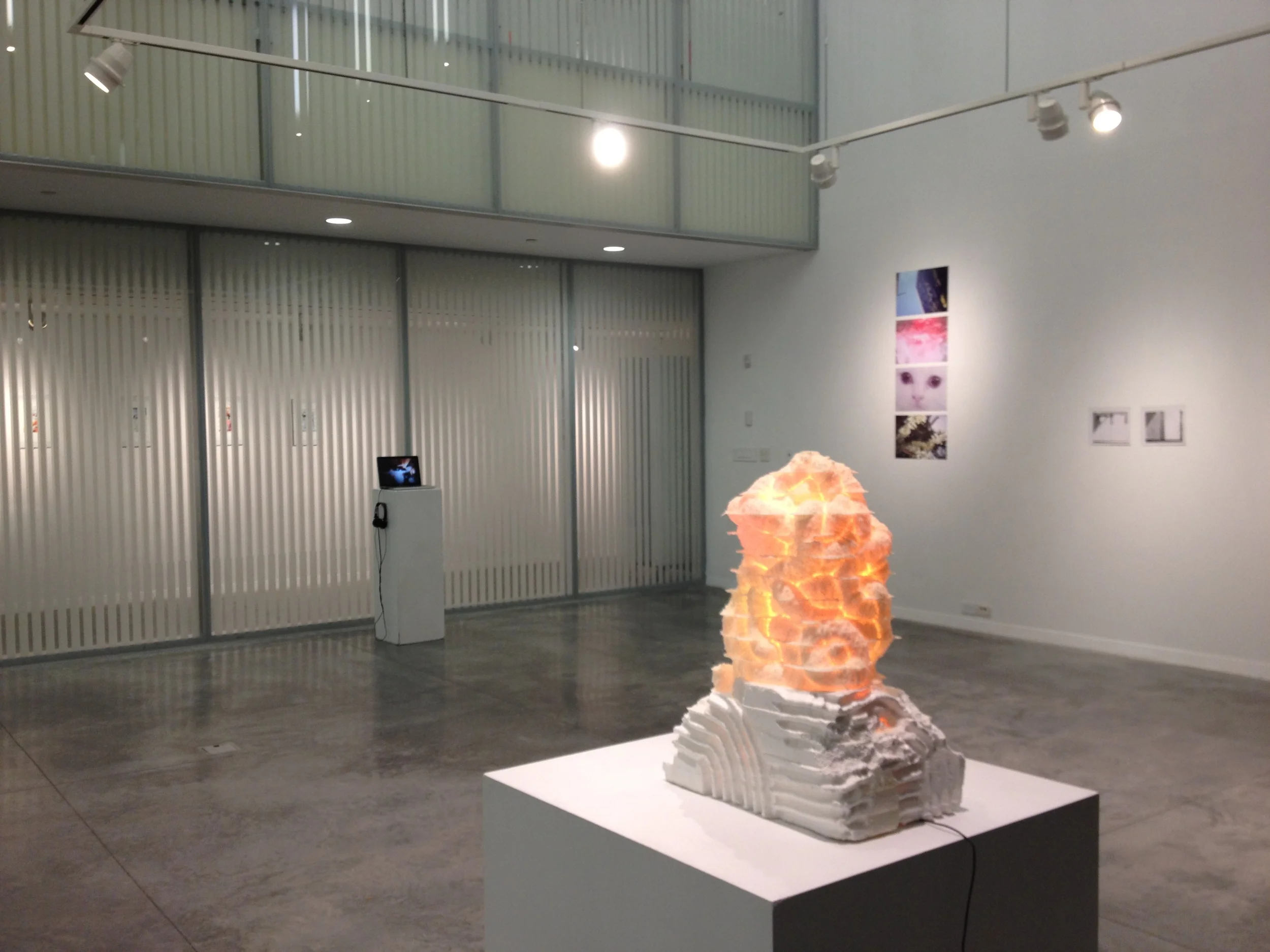
Enduring Ephemera | Louise McCagg Gallery at Barnard College
Alex Abelson, K Hole, Ian Jeffery, Hannah Kahng (BC’11), Melinda Kiefer, Benjamin Phelan, Ada Potter (BC’11), and Alyssa Rapp (BC’11)
Wendy Hui Kyong Chun coined the term “Enduring Ephemeral” in her book on digital memory, Programmed Visions, 2011 MIT Press. The phrase found immediate resonances in that it succinctly describes far more complex ideas that surround the conflation of digital storage and human memory.
As our external hard drives fill with GB of stored images, videos, books, music, and documents, what becomes of our understanding of memory? Almost everyone has experienced the failure of a digital device and the panicked sense of loss that follows. Nevertheless, we quickly replace failed components and begin to replenish our lost files with new media. YouTube videos flash by, catch on and quickly fall into a digital purgatory, the forgotten recent past. This interchangeability and quick restoration changes the status and weight of these files, specifically, images become less precious. We remain attached to the idea of them safely in storage yet rarely revisit them. Thus contemporary images are imbued with an “enduring ephemeral” quality, where they persist in digital storage while they are only encountered in a fleeting, transient space and time.
Fiber optic networks, cloud computing, and the pervasiveness of digital infrastructure have dramatically changed our sense of memory and created a unique temporality that did not exist before the Internet. How, as artists do we think about these shifts? What new problems arise from these invisible digital regimes? And what new possibilities become available?
The work in this show portrays a diverse response to these technological changes. They range from the media-savvy, digital works of K Hole to the concrete, site-specific sculptures of Melissa Kiefer. Benjamin Phelan and Alyssa Rapp all employ a kind of topographic method in approaching this new digital realm, tracing new surfaces and making the physical intangible.
Hannah Kahng’s webcam films portray a bizarre intimacy only available via a supposedly alienating technology. The images created by Alex Abelson and Ian Jeffery also hinge on a digital premise. A computer eye processes their work, filtering or cropping, gaining or losing data, and in the end they become new images in a world where no image can be new.
Although each artist’s approach is different, each work relies on a cyber consciousness, a digital vision or perspective that has only become possible in the last 15 years. This exhibition seeks to capture some of this perspective without affixing a fleeting, soon-to-be-obsolete point of view.





Enduring Ephemera | Louise McCagg Gallery at Barnard College
Alex Abelson, K Hole, Ian Jeffery, Hannah Kahng (BC’11), Melinda Kiefer, Benjamin Phelan, Ada Potter (BC’11), and Alyssa Rapp (BC’11)
Wendy Hui Kyong Chun coined the term “Enduring Ephemeral” in her book on digital memory, Programmed Visions, 2011 MIT Press. The phrase found immediate resonances in that it succinctly describes far more complex ideas that surround the conflation of digital storage and human memory.
As our external hard drives fill with GB of stored images, videos, books, music, and documents, what becomes of our understanding of memory? Almost everyone has experienced the failure of a digital device and the panicked sense of loss that follows. Nevertheless, we quickly replace failed components and begin to replenish our lost files with new media. YouTube videos flash by, catch on and quickly fall into a digital purgatory, the forgotten recent past. This interchangeability and quick restoration changes the status and weight of these files, specifically, images become less precious. We remain attached to the idea of them safely in storage yet rarely revisit them. Thus contemporary images are imbued with an “enduring ephemeral” quality, where they persist in digital storage while they are only encountered in a fleeting, transient space and time.
Fiber optic networks, cloud computing, and the pervasiveness of digital infrastructure have dramatically changed our sense of memory and created a unique temporality that did not exist before the Internet. How, as artists do we think about these shifts? What new problems arise from these invisible digital regimes? And what new possibilities become available?
The work in this show portrays a diverse response to these technological changes. They range from the media-savvy, digital works of K Hole to the concrete, site-specific sculptures of Melissa Kiefer. Benjamin Phelan and Alyssa Rapp all employ a kind of topographic method in approaching this new digital realm, tracing new surfaces and making the physical intangible.
Hannah Kahng’s webcam films portray a bizarre intimacy only available via a supposedly alienating technology. The images created by Alex Abelson and Ian Jeffery also hinge on a digital premise. A computer eye processes their work, filtering or cropping, gaining or losing data, and in the end they become new images in a world where no image can be new.
Although each artist’s approach is different, each work relies on a cyber consciousness, a digital vision or perspective that has only become possible in the last 15 years. This exhibition seeks to capture some of this perspective without affixing a fleeting, soon-to-be-obsolete point of view.





